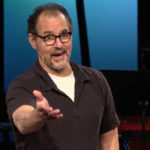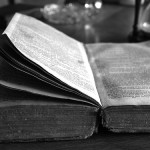We run our website the way we wished the whole internet worked: we provide high quality original content with no ads. We are funded solely by your direct support. Please consider supporting this project.

Two Questions to Unlock Violent Divine Portraits
There are two basic questions that help us to interpret what is going on in the violent portraits of God in the Old Testament, as I propose in Crucifixion of the Warrior God.
The First Question: What does the “God-breathed” revelation of the cross teach us about the nature of God’s “breathing”?
God “breathed” his supreme revelation on the cross by both acting toward us and by allowing others to act toward him. Because God honors the personhood of others, and because he therefore works by means of the influential power of the cross (1 Cor 1:18) rather than by exerting coercive power, God’s “breathing” is a dialectical rather than a unilateral process.
This cross-centered, dialectical understanding of the way God “breathes” should shape how we interpret the way that God “breathed” the Old Testament witness. We must read it with the awareness that it reflects both God acting toward us, insofar as God’s people at that time could receive it, as well as God humbly allowing others to act toward him, insofar as God had to accommodate his people’s fallen and culturally-conditioned hearts and minds. We must read the written witness of the OT knowing that portraits of God will display the same beautiful character as is revealed on the cross insofar as they reflect the former, but they will reflect the same ugliness of sin that is revealed on the cross insofar as they reflect the latter.
In this light, the OT’s violent portraits of God can be understood as testaments to the truth that God has always been willing to humbly stoop to bear the sin of his people and to thereby take on a literary semblance that mirrors the ugliness of this sin, just as he did in a historical way on the cross.
The Second Question: How does a guilty-appearing, godforsaken, crucified criminal become the definitive revelation of God for us?
It is not what everyone can see on the surface of the crucifixion that reveals God. Rather it is only when we by faith look through the surface of this event that it becomes the definitive revelation of God for us. Only by faith can we discern the Creator stooping an infinite distance to become this guilty-appearing, godforsaken, crucified criminal.
Since the God who “breathed” this paradigmatic revelation is the same God who “breathed” his written witness to this revelation, we should read Scripture expecting that there will be times when the revelatory content of a portrait of God is to be found not on its surface, but in its depth. The first can be understood by straightforward exegesis, but the second calls for faith to discern the humble, loving condescension of God.
However, we can only interpret the OT’s violent portraits in this sin-bearing way if we place our compete trust in the character of God revealed on the cross. If we suspect that God has a dark side and is capable of doing the monstrous things that the OT authors attribute to him, we will mistake the “shadow” for the “reality” (Col 2:17; Heb 10:1).
To put it another way, if we fail to place our trust in the revelation of the crucified Christ, we are trading the unclouded revelation of the Son, who alone is the “radiance of God’s glory” (Heb 1:3) for the cloudy perspective of ancient authors who could only catch “glimpses of truth” (Heb 1:1).
Only the slain lamb unlocks the secret of how macabre portraits of God point to him.
—Adapted from Crucifixion of the Warrior God, pages 1250-1252
Photo credit: Vitor Sá Photo via Visual Hunt / CC BY-NC-ND
Category: General
Tags: Crucifixion of the Warrior God, Cruciform Theology, OT Violence
Topics: Interpreting Violent Pictures and Troubling Behaviors
Related Reading

When the Law Demanded the Death Penalty
The Sinai covenant is significantly structured around violence. It motivates behavioral conformity by promising rewards and threatening violence. Without the threat of violence, the law looses its “teeth.” If the law is an acquiescence to sin, then the divinely sanctioned violence that is associated with it must also be considered an acquiescence to sin. The…

Podcast: Greg Introduces His Cruciform Hermeneutic at the CrossVision Conference and Dialogues with Rachel Held Evans
Greg Introduces His Cruciform Hermeneutic at the CrossVision Conference and Dialogues with Rachel Held Evans. http://traffic.libsyn.com/askgregboyd/Episode_0240.mp3

Quotes to Chew On: Conflicting Depictions of God
“This is something like the way I believe we should respond when we encounter biblical narratives that depict God doing things we can’t imagine Christ doing. For example, I can’t for a moment imagine Jesus—the one who made refusing violence and loving enemies a condition for being considered a child of God—commanding anyone to mercilessly…

Why Greg Can’t be Accused of Marcionism (Let’s Not Burn Him at the Stake Just Yet)
Kristin Brenemen via Compfight Richard Beck posted a blog today entitled It’s the Same God: On Marcionism, Creeds, Hermeneutics and War. You’re going to want to take the time to read through it in its entirety. Greg has been accused of Marcionism quite a lot as a result of the working out of his Cruciform…

God’s Moral Immutability
Classical theologians from the fourth and fifth centuries on were very concerned with protecting their understanding of the metaphysical attributes of God—like timelessness, immutability, impassibility—by assessing biblical portraits that conflicted with these attributes to be accommodations. However, once we resolve that all our thinking about God must be anchored in the cross, our primary concern…

An Alternative to Biblical Inerrancy
As with all other theological issues, when it comes to affirming that Scripture is “God-breathed,” everything hangs on where one starts. A dominant strand of the Evangelical tradition started with the assumption that, if God is perfect, and if Scripture is “God-breathed,” then Scripture must also be perfect or “inerrant.” Other “progressive” evangelicals have responded by…
